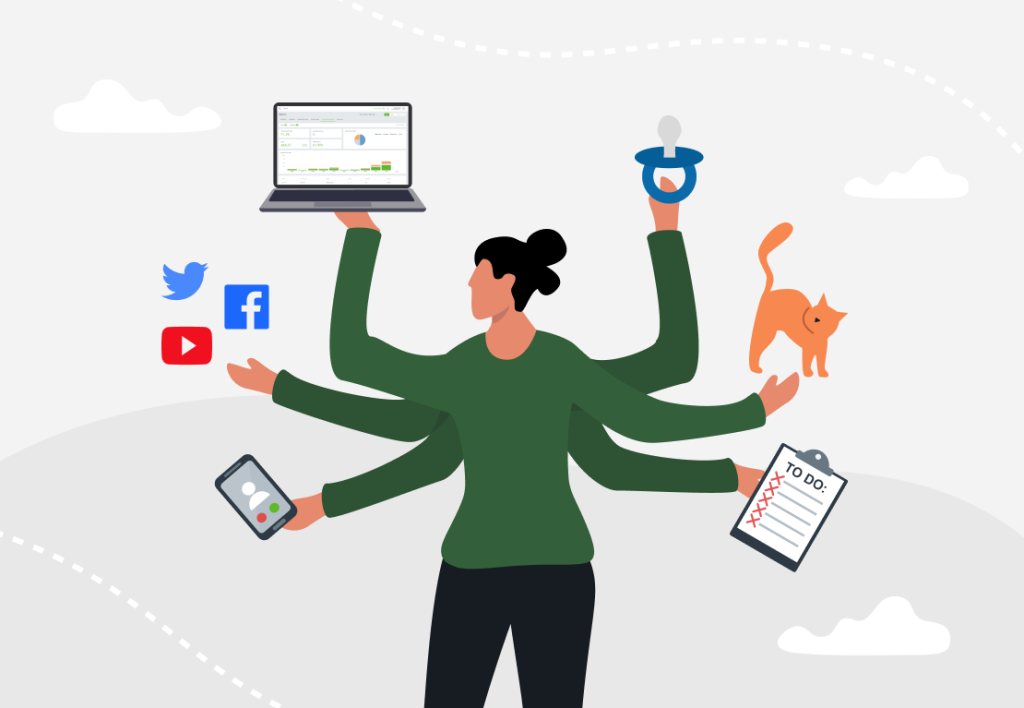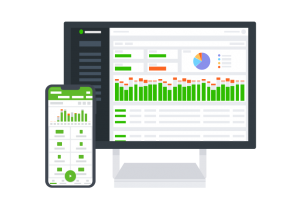How to avoid the negative effects of context switching

Context switching is hurting your productivity. And it’s not your fault. At least, not entirely.
In today’s office environment, a never-ending flow of tasks, communications, meetings, and other distractions pull your attention every which way. Even doing a single task often involves multiple digital spaces, as you may have to hop between various tools and documents to complete it.
Non-work distractions such as social media or doing the laundry when working from home aren’t doing our focus any favors either.
Want to get the most out of your time?
Try DeskTime for free!
Try free for 14 days · No credit card required.
By signing up, you agree to our terms and privacy policy.

All of the above affect your ability to perform at your best because, with every switch, you need to refocus and recalibrate to pick up where you left off. Some studies suggest that, on average, it takes 9 and a half minutes to get back into the flow of things after switching tasks. Other research puts the number at as much as 23 minutes.
This is known as context switching.
What is context switching?
Context switching is when you shift between tasks and tools before finishing the thing you’re currently working on. An example of context switching would be checking and responding to an email while drawing up a quarterly report, or having work interrupted by a meeting.
This causes cognitive strain as your attention is pulled in multiple directions. You need to switch contexts to be able to deal with whatever pops up and any work inertia you had going for an active task is instantly sapped, eating up valuable time and energy.
Moreover, in the modern work environment, it’s rarely just two things vying for your attention. Instant messaging platforms, project management tools, and email are all examples of always-on elements that persistently bombard your daily workflow, tearing you away from deep, value-added work.
The reality is that our brains aren’t wired to operate like this – our ‘working’ memory is very limited. Accordingly, extended periods of hectic context switching can quickly lead to mental fatigue and, in turn, underperformance.
It’s a productivity killer. Even if, for instance, you’ve blocked all social media and are 100% focused on work-related activities, you might still find yourself struggling to stay productive when your day looks like a hodgepodge of different, overlapping tasks.
The cost of context switching on productivity and your employees
Constantly bouncing between tasks is mentally taxing and thus may not only hamper work productivity, but also negatively impact personal well-being. Accordingly, there are two main ways how context switching may harm you and your team:
- Decrease in productivity – getting back into the groove of things after a distraction takes time and it’s time that we rarely account for when planning our work. As a result, because of context switching, it often takes longer to finish tasks, you get less done in a day, and the overall quality suffers as trains of thought get lost and tasks get rushed.
- Increase in mental fatigue – research shows that most professionals spend less than two minutes on a task before getting interrupted and 43% say it’s tiring to switch between tasks. Accordingly, constant context shifting makes each task more exhausting and makes you feel like you get less done, potentially leading to overworking and burnout at no fault of your own – two things that have already become among the most pressing issues of the modern office environment.
While some level of context switching and multitasking is virtually unavoidable in any workplace, managers and team leads must be aware of the deleterious effects of dragging people away from deep work. Of course, there are certain measures employees can undertake to minimize these effects, too.
4 tips and tricks to avoid the negative effects of context switching
Generally speaking, it all boils down to good time management and eliminating distractions when possible. Doing so will allow your team to perform better and get more done. So here are four practical ideas for how to achieve this.
1. Talk openly about context switching
One of the biggest problems with task switching is that it’s rarely discussed openly, despite nearly half of people reporting it as an unwelcome element of their work. The notable part is that the other half don’t regard it as such. This means they might oppose certain initiatives to curb multitasking, as it might impact their own preferred ways of working and productivity.
Others yet might not even be aware of the cost of context switching. So, before moving on to the more hands-on tips below, it’s a good idea to get the team on the same page, discuss whether they would benefit from re-evaluating their work habits, and find common ground that works for all sides.
2. Review your productivity patterns
Simply removing distractions won’t magically make you productive. The reality is that we each peak at different times of day and the smartest way to minimize the negative effects of context switching on productivity is to safeguard the windows of time when we perform at our best.
For example, if you’re highly productive in the morning but always have a slump after lunch, it makes sense to avoid distractions such as meetings or checking emails in the early hours and leave those things for later.
Time tracking tools such as DeskTime can shed valuable insight on your productivity patterns by tracking where and how you spend your time throughout the day. This can make it easy to identify your productivity peaks and throughs, thus better informing any decisions about reducing the impact of context switching.
3. Make use of productivity techniques
Once you’ve identified the time windows to protect, it’s up to you to make the most of them. To do so, various productivity techniques may come in handy. It can be simple things such as to-do lists to ensure you complete the most crucial tasks, as well as more advanced methods such as time blocking.
Time blocking is particularly pertinent to minimizing task switching. It’s a time management technique to help you hyperfocus on a particular task by breaking your day into allotted segments which helps to boost productivity and get things done faster. Splitting your schedule into themed blocks ensures that you dedicate enough time to your primary responsibilities while giving yourself the permission to ignore all other non-urgent things.

Make sure you stay focused on the right tasks
DeskTime’s time tracker lets you see where your time goes throughout the day.
4. Foster a healthy meeting culture
One of the biggest productivity killers are meetings. Particularly unstructured and unnecessary ones. Research suggests about 70% of meetings keep employees from doing productive work and, unfortunately, remote work has produced an uptick in the frequency of meetings.
All the time blocking and productivity planning in the world won’t help if your boss schedules meetings when you’re at your most productive. It’s definitely one of the things to discuss in your team talk about context switching.
In short, the fewer meetings the better. But those that do take place must be structured and purposeful. Every meeting should have an agenda, a set time limit, and a summary with explicit action plans. It’s also a good idea to allow people to bow out of meetings where they feel they have little to nothing to contribute and enforce this practice at all levels of your organization.
Hot tip: a great way to curb the number of meetings and their impact on productivity is to designate 1-2 days a week as meeting-free, where all but the most, most, most urgent meetings are discouraged, giving space to uninterrupted work.
Final remarks
Combatting context switching takes significant effort and alignment between the entire team, but the potential outcome is increased productivity and a better working environment. This, in turn, has many other valuable knock-on benefits from higher output to happier employees.
Still, we’re so used to instantly responding to Slack messages and emails that it can take a while to unlearn these bad habits. And that’s fine, as long as it’s a shared effort by the entire team.
So, to summarize, discuss context switching, identify the damage it causes, implement techniques for deep work, and trim the distraction fat as much as possible.
Did you find this article useful? Give it a clap!
Psst! You can clap more than once if you really loved it 🙂